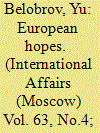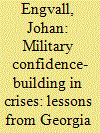| Srl | Item |
| 1 |
ID:
146718


|
|
|
|
|
| Contents |
For some years now, conventional arms control in Europe has found itself under pressure. The edifice of conventional arms control instruments in Europe consists of three main pillars; the Vienna document on confidence- and security-building measures, most recently updated in 2011; the conventional armed forces in Europe (CFE) treaty, which entered into force in 1992; and the open skies treaty, which entered into force in 2002.
|
|
|
|
|
|
|
|
|
|
|
|
|
|
|
|
| 2 |
ID:
155340


|
|
|
|
|
| Summary/Abstract |
THE REGIME for conventional arms control in Europe, established in the 1990s after the end of the Cold War, was for those years a unique set of measures and was seen as a model suitable for other parts of the world as well. However, destructive activities by NATO member countries over the past two decades have eroded it and threaten to ruin it completely if these activities are not stopped. The Treaty on Conventional Armed Forces in Europe (CFE), which was considered the cornerstone of this regime, is practically dead.
|
|
|
|
|
|
|
|
|
|
|
|
|
|
|
|
| 3 |
ID:
173161


|
|
|
|
|
| Summary/Abstract |
What role can conventional arms control (CAC) and confidence- and security-building measures (CSBMs) play in crises and conflicts? By examining the use of CAC and CSBMs during the Russian-Georgian war in 2008 and during Russia’s annexation of Crimea and the war in eastern Ukraine in 2014, the present article argue that CAC and CSBMs are unable to prevent intentional conflict. Their more realistic value in crises is to function as early warning mechanisms that raise the bar for and increase the costs of conflict as well as serving as instruments to monitor conflicts. To increase their effectiveness, the links between early warning and early action need strengthening and several ambiguities need to be removed, particularly form the Vienna Document, in order to improve indicators, increase warning times and raise the political costs of non-compliance. Nonetheless, when one or two sides seek a conflict, CAC and CSBMs do not provide a remedy for conflict prevention.
|
|
|
|
|
|
|
|
|
|
|
|
|
|
|
|